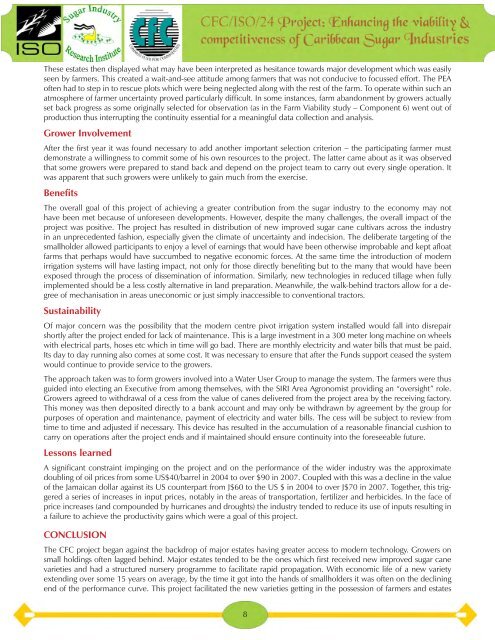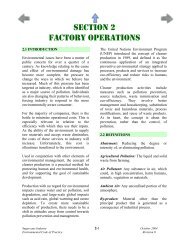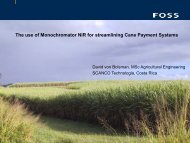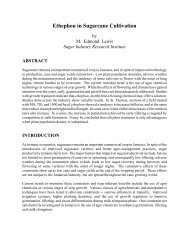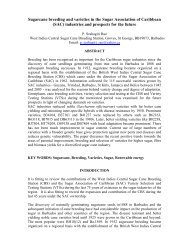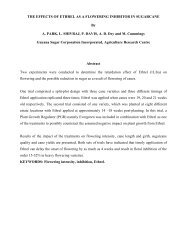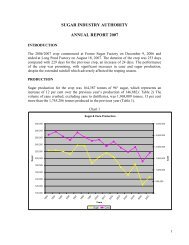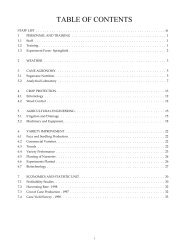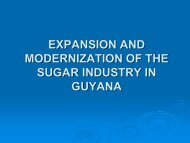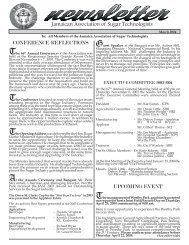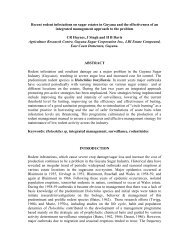Overview - The Jamaican Sugar Industry
Overview - The Jamaican Sugar Industry
Overview - The Jamaican Sugar Industry
You also want an ePaper? Increase the reach of your titles
YUMPU automatically turns print PDFs into web optimized ePapers that Google loves.
<strong>The</strong>se estates then displayed what may have been interpreted as hesitance towards major development which was easilyseen by farmers. This created a wait-and-see attitude among farmers that was not conducive to focussed effort. <strong>The</strong> PEAoften had to step in to rescue plots which were being neglected along with the rest of the farm. To operate within such anatmosphere of farmer uncertainty proved particularly difficult. In some instances, farm abandonment by growers actuallyset back progress as some originally selected for observation (as in the Farm Viability study – Component 6) went out ofproduction thus interrupting the continuity essential for a meaningful data collection and analysis.Grower InvolvementAfter the first year it was found necessary to add another important selection criterion – the participating farmer mustdemonstrate a willingness to commit some of his own resources to the project. <strong>The</strong> latter came about as it was observedthat some growers were prepared to stand back and depend on the project team to carry out every single operation. Itwas apparent that such growers were unlikely to gain much from the exercise.Benefits<strong>The</strong> overall goal of this project of achieving a greater contribution from the sugar industry to the economy may nothave been met because of unforeseen developments. However, despite the many challenges, the overall impact of theproject was positive. <strong>The</strong> project has resulted in distribution of new improved sugar cane cultivars across the industryin an unprecedented fashion, especially given the climate of uncertainty and indecision. <strong>The</strong> deliberate targeting of thesmallholder allowed participants to enjoy a level of earnings that would have been otherwise improbable and kept afloatfarms that perhaps would have succumbed to negative economic forces. At the same time the introduction of modernirrigation systems will have lasting impact, not only for those directly benefiting but to the many that would have beenexposed through the process of dissemination of information. Similarly, new technologies in reduced tillage when fullyimplemented should be a less costly alternative in land preparation. Meanwhile, the walk-behind tractors allow for a degreeof mechanisation in areas uneconomic or just simply inaccessible to conventional tractors.SustainabilityOf major concern was the possibility that the modern centre pivot irrigation system installed would fall into disrepairshortly after the project ended for lack of maintenance. This is a large investment in a 300 meter long machine on wheelswith electrical parts, hoses etc which in time will go bad. <strong>The</strong>re are monthly electricity and water bills that must be paid.Its day to day running also comes at some cost. It was necessary to ensure that after the Funds support ceased the systemwould continue to provide service to the growers.<strong>The</strong> approach taken was to form growers involved into a Water User Group to manage the system. <strong>The</strong> farmers were thusguided into electing an Executive from among themselves, with the SIRI Area Agronomist providing an “oversight” role.Growers agreed to withdrawal of a cess from the value of canes delivered from the project area by the receiving factory.This money was then deposited directly to a bank account and may only be withdrawn by agreement by the group forpurposes of operation and maintenance, payment of electricity and water bills. <strong>The</strong> cess will be subject to review fromtime to time and adjusted if necessary. This device has resulted in the accumulation of a reasonable financial cushion tocarry on operations after the project ends and if maintained should ensure continuity into the foreseeable future.Lessons learnedA significant constraint impinging on the project and on the performance of the wider industry was the approximatedoubling of oil prices from some US$40/barrel in 2004 to over $90 in 2007. Coupled with this was a decline in the valueof the <strong>Jamaican</strong> dollar against its US counterpart from J$60 to the US $ in 2004 to over J$70 in 2007. Together, this triggereda series of increases in input prices, notably in the areas of transportation, fertilizer and herbicides. In the face ofprice increases (and compounded by hurricanes and droughts) the industry tended to reduce its use of inputs resulting ina failure to achieve the productivity gains which were a goal of this project.CONCLUSION<strong>The</strong> CFC project began against the backdrop of major estates having greater access to modern technology. Growers onsmall holdings often lagged behind. Major estates tended to be the ones which first received new improved sugar canevarieties and had a structured nursery programme to facilitate rapid propagation. With economic life of a new varietyextending over some 15 years on average, by the time it got into the hands of smallholders it was often on the decliningend of the performance curve. This project facilitated the new varieties getting in the possession of farmers and estates8


